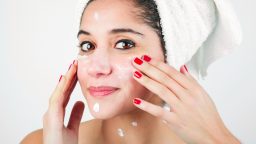Stretch marks are a common skin concern that many people experience at some point in their lives. These lines, which can appear on the skin when it stretches rapidly due to factors such as pregnancy, growth spurts, weight fluctuations, or even intense workouts, can often be difficult to avoid. However, while it may not be possible to completely prevent stretch marks, there are several proactive steps you can take to reduce the likelihood of developing them and help your skin remain smooth and elastic. Here’s how you can prevent stretch marks and care for your skin to keep it looking its best.
- Maintain a Healthy and Balanced Diet
Your skin’s elasticity is greatly affected by the nutrients you consume. Eating a balanced diet that’s rich in vitamins and minerals can help support skin health and may reduce the risk of stretch marks.
- Vitamin C: This vitamin plays a vital role in collagen production, which helps keep your skin strong and elastic. Incorporate foods like oranges, strawberries, bell peppers, and broccoli into your diet to ensure you’re getting enough vitamin C.
- Vitamin E: Known for its ability to support skin healing and repair, vitamin E helps keep the skin hydrated and elastic. Foods like almonds, sunflower seeds, and avocados are excellent sources of vitamin E.
- Zinc: Zinc is crucial for cell growth and tissue repair, which can support your skin’s ability to stretch. Foods like beans, nuts, seeds, and whole grains can help you meet your zinc needs.
- Healthy Fats: Omega-3 fatty acids, found in foods like salmon, flaxseeds, and walnuts, are important for maintaining your skin’s moisture barrier, making it less likely to crack under pressure.
Incorporating these nutrients into your daily diet can support your skin’s overall health and elasticity, making it more resistant to stretch marks.
- Keep Your Skin Well-Hydrated
Dry skin is more prone to developing stretch marks, as it can become less elastic and more vulnerable to damage when stretched. To help prevent stretch marks, it’s crucial to keep your skin well-hydrated both internally and externally.
- Drink Plenty of Water: Staying hydrated from the inside out is essential for maintaining the skin’s elasticity. Aim to drink at least 8 glasses of water per day to keep your skin hydrated and supple.
- Use Moisturising Creams and Oils: Applying moisturisers regularly can help lock in hydration and improve skin elasticity. Look for creams or oils that contain ingredients like shea butter, cocoa butter, or hyaluronic acid. These ingredients are known to nourish and hydrate the skin, helping to keep it smooth and more resistant to stretching.
Regularly applying moisturisers, especially during times of rapid skin stretching (like pregnancy or weight gain), can significantly reduce the risk of stretch marks forming.
- Use Topical Products with Stretch Mark Prevention Ingredients
There are many topical treatments on the market designed to prevent or reduce the appearance of stretch marks. While these products may not completely eliminate stretch marks, they can help improve skin elasticity and promote healing. Some key ingredients to look for include:
- Retinoids (Vitamin A): Retinoids, such as retinol, are known to increase collagen production and improve skin texture, making them a popular ingredient in many stretch mark creams. However, retinoids should be avoided during pregnancy, as they can potentially harm the developing baby.
- Centella Asiatica: This herbal extract has been shown to improve the appearance of stretch marks by stimulating collagen production and promoting skin regeneration. Look for creams or oils containing centella asiatica to help keep your skin elastic.
- Hyaluronic Acid: Known for its ability to draw moisture into the skin, hyaluronic acid helps keep the skin hydrated and plump. This ingredient may improve skin elasticity and reduce the likelihood of stretch marks forming.
- Cocoa Butter or Shea Butter: These natural butters are rich in vitamins and fatty acids that help keep the skin nourished and moisturised. Regular use of cocoa or shea butter can improve skin elasticity and keep it supple, reducing the chances of stretch marks.
Be consistent with using these products, applying them daily to areas that are prone to stretching, such as the abdomen, thighs, hips, and breasts.
- Maintain a Healthy Weight
Fluctuating weight can be a major contributor to the development of stretch marks. Rapid weight gain or loss can overstretch the skin and cause the collagen and elastin fibers to break, leading to the formation of stretch marks.
To help prevent stretch marks, aim to maintain a stable, healthy weight. If you are looking to lose weight, do so gradually, as rapid weight loss can lead to excess skin stretching. Similarly, if you are gaining weight, try to do so at a moderate pace to allow your skin to adapt to the changes.
A balanced diet and regular exercise are key to maintaining a healthy weight and supporting your skin’s elasticity.
- Exercise Regularly
Regular physical activity can help prevent stretch marks by improving skin tone and increasing blood circulation, which supports skin health. Strength training exercises, in particular, help build muscle mass and prevent the skin from sagging or stretching too quickly.
Exercise also boosts the production of collagen and elastin, two important proteins that help keep your skin firm and resilient. Focus on a combination of cardiovascular exercises and strength training to maintain a healthy body and skin.
Additionally, staying active helps you maintain a healthy weight, which reduces the risk of stretch marks due to rapid weight changes.
- Be Mindful During Pregnancy
Pregnancy is one of the most common times for women to experience stretch marks, as the skin stretches rapidly to accommodate the growing baby. While stretch marks may be inevitable for some women, there are ways to reduce the likelihood of developing them.
- Stay Hydrated: Drinking plenty of water during pregnancy will keep your skin hydrated and support its elasticity.
- Use Preventative Creams: Many women use specially formulated stretch mark creams or oils during pregnancy to keep their skin moisturised and elastic. Products containing cocoa butter, shea butter, or vitamin E are commonly recommended during pregnancy to help prevent stretch marks.
- Focus on Gradual Weight Gain: Gradual weight gain during pregnancy can help your skin adjust to the changes more easily. Aim to follow the weight gain recommendations set by your healthcare provider to avoid excessive stretching of the skin.
While some stretch marks are inevitable, taking care of your skin during pregnancy can help reduce their severity.
- Wear Comfortable Clothing
Tight clothing that doesn’t allow your skin to stretch comfortably can cause friction and irritation, which may contribute to the development of stretch marks. Opt for clothing that fits well without constricting your skin, especially in areas prone to stretch marks, like the abdomen, thighs, and breasts.
If you’re pregnant, wearing comfortable, supportive maternity wear can help reduce strain on your skin and allow it to stretch more naturally.
- Avoid Steroid Use Without Medical Supervision
Topical and oral steroids can weaken the skin, making it more prone to stretch marks. If you are prescribed steroid medication, use it only as directed by a healthcare provider and avoid overuse. If you are concerned about stretch marks related to steroid use, discuss alternatives with your doctor.
Conclusion
While it may not always be possible to completely prevent stretch marks, incorporating these habits into your daily routine can significantly reduce the likelihood of developing them. By maintaining a healthy diet, staying hydrated, using the right topical products, and practicing gradual weight management, you can help your skin stay elastic and strong. Remember, stretch marks are a natural part of life for many people, and they don’t define your beauty. However, with these prevention tips, you can support your skin’s health and reduce the chances of developing stretch marks.





